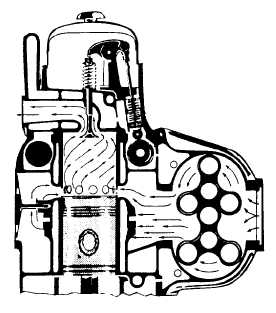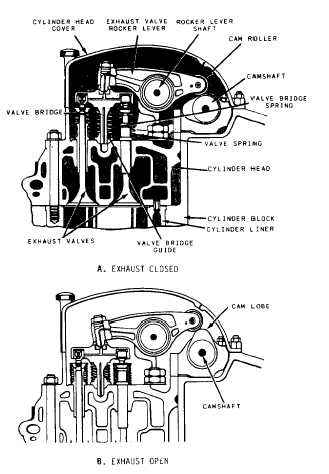Figure 7-6.—A two-stroke diesel engine cylinder with the
piston at the bottom of the power stroke.
the intake and exhaust strokes of the four-
stroke cycle.
You might expect a two-stroke engine to
develop twice as much power as a four-stroke
engine of the same size and to operate at the same
speed. However, this is not true. With two-stroke
diesel engines, some of the power is used to drive
a blower (fig. 7-6) that forces the air charge into
the cylinder under pressure. Also, the burned
gases are not completely cleared from the cylinder,
reducing combustion efficiency. Additionally,
because of the much shorter period the intake
ports are open (as compared to the period the
intake valve in a four-stroke cycle is open), a
smaller amount of air is admitted. Therefore, with
less air being mixed with the fuel, less power-per-
power stroke is produced. Nevertheless, two-
stroke diesel engines give excellent service.
VALVE MECHANISM
The valve mechanism of a two-stroke diesel
cylinder head is shown in figure 7-7. This cylinder
head has two exhaust valves that are opened at
the same time by the action of a single cam. They
make a tight fit in the exhaust openings (ports)
in the cylinder head and are held in the closed
position by the compression of the valve springs.
The rocker arm and bridge transmit the
reciprocating motions of the cam roller to the
valves.
Figure 7-7.—A two-stroke diesel cylinder head, showing the
valve-operating mechanism.
In figure 7-7, view A, the cam roller is riding
on the base circle of the cam, and the valves are
closed. As the camshaft rotates, the cam lobe or
nose rides under the roller and raises it to the
position shown in view B. When the roller is lifted,
the arm rotates around the rocker shaft; and the
opposite end of the arm is lowered. This action
pushes the bridge and valves down against the
pressure of the valve springs and opens the valve
passages.
On some types of engines, the camshaft is
located near the crankshaft. In these designs, the
action of the cam roller is transmitted to the
rocker arm by a pushrod.
The camshaft must be timed with the crank-
shaft so that the lobes will open the valves in each
cylinder at the correct instant in the operating
cycle. In the two-stroke engine, the camshaft
rotates at the same speed as the crankshaft.
The four-stroke engine has an intake valve and
an exhaust valve in every cylinder. Each valve is
7-7




